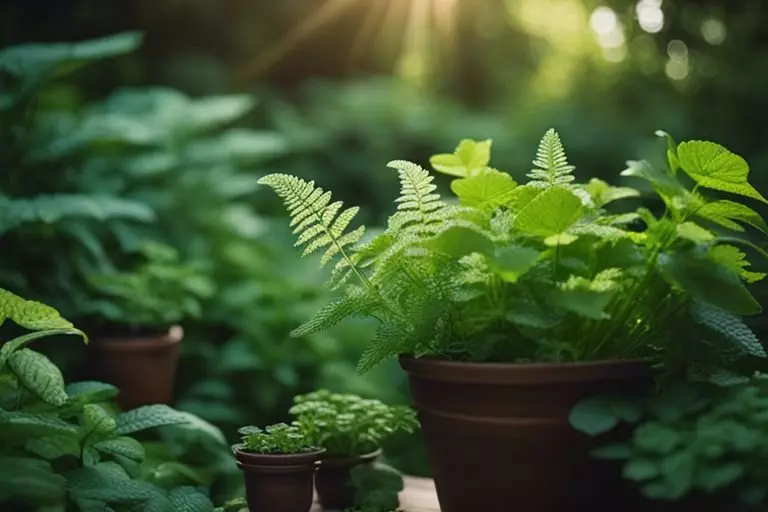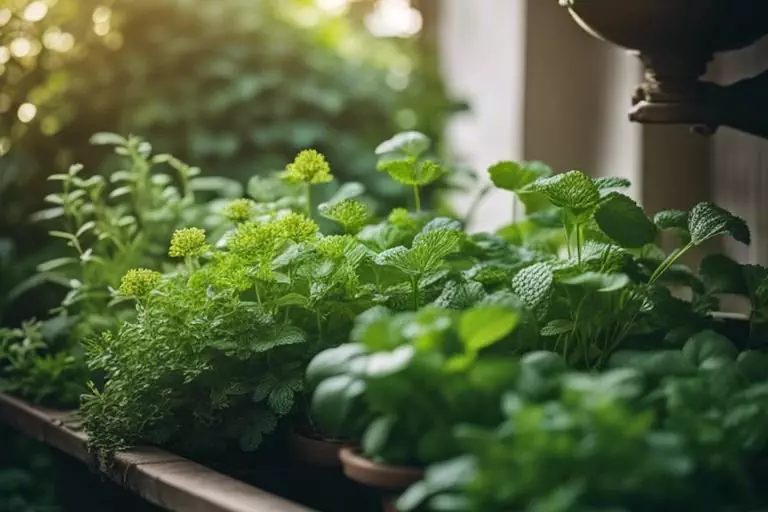
Many urban gardeners face the challenge of growing herbs in shady spots, but fear not! With the proper knowledge and selection of herbs, even low-light conditions can yield lush and aromatic results. This guide will explore five must-have herbs that survive and thrive in limited sunlight. From the versatile mint to the robust parsley, delightful chives, gourmet tarragon, and aromatic lemon balm, these herbs offer flavorful benefits that can transform your shaded garden into a vibrant haven. Let’s dive in and discover how to cultivate a thriving herb garden in even the darkest corners!
Key Takeaways:
- Mint, parsley, chives, tarragon, and lemon balm are five versatile herbs that thrive in low-light conditions, making them perfect choices for shady urban gardens.
- When growing herbs in shady spots, observing sunlight movement, selecting the right herbs, managing the soil properly, controlling moisture, and maximizing light exposure are imperative.
- Container gardening, regular trimming, and companion planting are effective strategies for maintaining and enhancing the growth of shade-loving herbs in urban environments with limited sunlight.

Understanding Shady Gardens
Defining Shade
Your shady garden may receive less than four hours of direct sunlight daily. It’s crucial to understand the different types of shade—light, partial, complete, and deep shade—because not all shadows are created equal! Light and partial shades are your best bet for herb gardening as they offer some sun. Full and deep shades can be more challenging but not impossible.
Assessing Your Garden’s Light Conditions
For those of you wondering about the light conditions in your garden, observe how sunlight moves across your space throughout the day. Notice which areas get the most light and at what times. This simple step will help you choose the right spot for your herbs, ensuring they get the glow they need to grow. If you live in a city with limited outdoor space that doesn’t get much sunlight, understanding your garden’s light conditions is crucial for a thriving herb garden.
Assessing your garden’s light conditions might seem tricky, but it’s pretty straightforward. Observe how sunlight moves across your space throughout the day. Notice which areas get the most light and at what times. This simple step will help you choose the right spot for your herbs, ensuring they get the glow they need to grow.

Mint: A Hardy and Versatile Herb
Growing Mint in Shady Conditions
Some urban gardeners may avoid growing herbs in shady conditions, but mint is here to prove them wrong. This versatile herb thrives in low-light settings and adds a fresh, excellent flavor to dishes and beverages. Mint, whether spearmint or peppermint, is a fantastic addition to any garden and can flourish even in areas with limited sunlight.
Containing Mint’s Growth with Container Gardening
For those concerned about mint’s spreading nature, container gardening is a fantastic solution. Planting mint in pots or containers helps contain its vigorous growth and prevents it from taking over other plants in the garden. Additionally, mint in containers can create a lovely and aromatic display on patios or balconies that receive limited sunlight. So, don’t hesitate to add some mint to your shady herb garden!
The key to successful container gardening with mint lies in choosing a pot with good drainage, using a quality potting mix, and regularly trimming the plant to promote new growth. Following these simple steps, you can enjoy a bountiful harvest of mint throughout the growing season.
Parsley: A Robust and Nutritious Herb
Many herb gardeners are familiar with parsley, a robust herb that not only adds a bright, fresh flavor to dishes but also provides various nutritional benefits. Thriving in partial shade, parsley is easy to grow and a staple for garnishing soups and sauces in kitchens.
Thriving in Partial Shade
Partial shade provides the perfect environment for parsley to flourish. Parsley prefers partial shade and can thrive in areas with limited sunlight, making it ideal for shady garden spots. This herb’s ability to succeed in such conditions allows gardeners in urban settings with less sunny spaces to enjoy a bountiful harvest of this nutritious herb.
Soil and Water Requirements
Parsley thrives in rich, well-draining soil and requires adequate water, especially during drier periods. Maintaining soil quality is crucial to avoid waterlogging sensitive roots. Incorporating organic matter like compost can significantly improve soil texture and nutrient content, contributing to the herb’s overall health.
Understanding parsley’s soil and water requirements is crucial for ensuring a flourishing herb garden in shady conditions. By providing the proper soil structure and moisture levels, herb growers can help parsley thrive even in areas with limited sunlight, allowing them to enjoy a continuous supply of this versatile herb.
Regular Trimming for Fuller Growth
Regular trimming of parsley is crucial to encouraging fuller growth and a bountiful harvest. Cutting the herb with scissors leaves about two inches from the base, promoting regrowth and ensuring a continuous supply throughout the growing season. This practice helps maintain the plant’s health and enhances its aesthetic appeal in the garden.
Shade gardening with parsley can be a rewarding experience. This herb’s resilience and nutritional benefits make it a valuable addition to any herb garden, even in areas with limited sunlight. With the proper care and attention, parsley can thrive in partial shade, providing an abundant source of fresh flavor for various culinary creations.

Chives: Easy to Manage and Delicious
Flourishing in Low-Light Conditions
Despite their mild onion flavor, chives are easy to manage in shady gardens and thrive in low-light conditions. Their resilience makes them perfect for less sunny spots where other herbs might struggle. Chives can flourish in areas with limited sunlight, adding a fresh touch to dishes like salads, omelets, and sauces.
Harvesting and Regrowing Chives
Manage chives by simply snipping the leaves with scissors, leaving about two inches from the base to promote regrowth. This straightforward method ensures a continuous supply throughout the growing season. Regular trimming chives will help keep them under control and encourage fuller growth, allowing for a bountiful harvest.
Easy to care for and versatile in the kitchen, chives can be a lovely addition to your herb garden. With minimal maintenance, you can enjoy a steady supply of this flavorful herb at your fingertips.
Edible Flowers for Added Beauty
Flourishing in shaded areas, chives offer their delightful flavor and a visual appeal with their purple or white edible flowers. These flowers not only add beauty to your garden but are also a tasteful addition to your plate, enhancing both the aesthetics and flavors of your dishes.
Edible flowers from chives can be a fun and unique way to elevate your culinary creations while beautifying your garden at the same time. Don’t underestimate the added charm and flavor these flowers can bring to your shady herb garden!
Tarragon: A Flavorful Herb for Shade
Appreciating Light Shade
Not all herbs thrive in direct sunlight; tarragon appreciates light shade, especially in hotter climates. Providing this herb with a protective canopy from the harsh afternoon sun can help maintain its delicate flavors, which elevate many dishes.
Soil and Water Requirements
Attention to their soil and water needs is crucial to ensure your tarragon plants are healthy and productive. Tarragon prefers well-drained soil and requires regular watering, particularly during dry spells. Balancing moisture levels is critical to successful tarragon cultivation.
This herb prefers well-drained soil and regular watering, which means avoiding soggy conditions. Incorporating organic matter like compost can significantly improve soil texture and nutrient content, ensuring your tarragon thrives in its shaded environment.
Propagation Methods for Expanding Your Supply
For gardeners looking to expand their tarragon supply without much hassle, propagation methods like root division or cuttings can be instrumental. These techniques allow you to multiply your tarragon plants and enjoy an abundant harvest of flavorful herbs.
Expanding your tarragon collection through propagation methods provides you with more plants to enjoy. It allows you to share the joy of growing this versatile herb with fellow urban gardeners facing similar shady conditions.
Lemon Balm: A Refreshing and Calming Herb
Thriving in Partial to Full Shade
All lemon balm enthusiasts know this herb is a refreshing and calming addition to any garden. Thriving in partial to full shade, lemon balm’s aromatic leaves are delightful and offer a range of culinary uses. Known for its refreshing lemon scent and calming properties, lemon balm is a fantastic choice for those looking to add a touch of tranquility to their garden.
Managing Growth to Prevent Invasiveness
Any herb gardener knows the importance of managing the growth of their plants to prevent invasiveness. Regarding lemon balm, regular harvesting is critical to keeping it under control while encouraging new growth. This process ensures a steady supply of this flavorful herb and maintains a balanced garden landscape.
Planting in Containers for Control
A well-maintained garden is essential for the successful growth of lemon balm. Planting this herb in containers can help contain its spread and prevent it from taking over your garden. This method controls the development of lemon balm and allows for easy management and maintenance. By utilizing containers, you can enjoy the benefits of lemon balm without worrying about its invasive tendencies.
Creating the Best Environment for Shade-Loving Herbs
Focus on the right environment to keep your Shade-Tolerant Herbs From The Grower’s Exchange happy and thriving. This includes ensuring adequate soil quality, managing moisture levels properly, and maximizing light exposure.
Soil Quality and Organic Matter
To provide the best-growing conditions for your shade-loving herbs, start by focusing on soil quality. Rich and well-draining soil is crucial to avoid waterlogging sensitive roots. Incorporating organic matter like compost can significantly improve soil texture and nutrient content, providing a healthy foundation for your herbs to flourish.
Moisture Management and Avoiding Overwatering
In addition to soil quality, proper moisture management is critical to the success of your shade-loving herb garden. While some herbs prefer moist conditions, avoiding overwatering is essential, which can lead to root rot and other issues. Remember to water when the top inch of soil feels dry, ensuring your herbs receive adequate hydration without drowning them.
With these simple but crucial practices, you can maintain a thriving herb garden even in low-light conditions. Paying attention to soil quality, organic matter, and moisture levels will create an optimal environment for your shade-loving herbs to grow strong and healthy.
Maximizing Light Exposure with Reflective Surfaces and Companion Planting
Quality light exposure plays a vital role in the growth of shade-loving herbs. Consider utilizing reflective surfaces like light-colored walls or fences near your plants to bounce additional light onto them, enhancing their growth even without direct sunlight. Furthermore, companion planting can be beneficial as certain combinations can boost growth and flavor, creating a harmonious ecosystem in your garden.
Maximizing light exposure in shady garden areas is crucial. Reflective surfaces and strategic companion planting help your herbs thrive and contribute to a more vibrant and productive garden.
Summing up
As we end our exploration into growing herbs in low-light conditions, it’s clear that even the darkest corners of our urban gardens can be transformed into thriving herb havens. By selecting the right herbs, such as mint, parsley, chives, tarragon, and lemon balm, and understanding their care needs, we can create lush, aromatic spaces that beautify our surroundings and enhance our culinary experiences.
So, don’t be discouraged by a lack of sunlight in your garden. You can turn those shady spots into flourishing herb sanctuaries with some knowledge, love, and attention. Embrace the challenge, experiment with new herbs, and enjoy the bountiful rewards of nurturing these green companions. Happy gardening, and may your urban oasis be filled with the vibrant flavors and scents of these fantastic herbs!
Frequently Asked Questions
Q: Can I grow herbs in low-light conditions?
A: Yes, you can! Several herbs, such as mint, parsley, chives, tarragon, and lemon balm, thrive in shady spots. With the proper selection and care, you can create a lush herb garden even in areas with limited sunlight.
Q: How do I assess the light conditions in my garden to determine if it’s suitable for growing herbs?
A: To assess the light conditions in your garden, observe how sunlight moves across the space throughout the day. Look for areas that receive less than four hours of direct sunlight, considered shady spots. Understanding the type of shade—light, partial, complete, or deep—will help you choose the right herbs for your garden.
Q: What are some tips for caring for herbs in low-light conditions?
A: To care for herbs in shady spots, ensure the soil is rich and well-draining to avoid waterlogging. Water your herbs regularly, but be cautious not to overwater. Consider using reflective surfaces to maximize light exposure, and explore companion planting to enhance growth and flavor. With these tips, your herbs will thrive even in low-light conditions.
